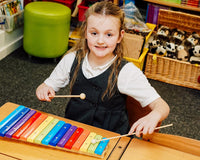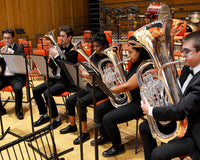
The oboe is one of the oldest members of the modern woodwind family, and has been a prominent feature of musical ensembles over the centuries, appearing in various forms. Playing in the key of C, the oboe is a soprano instrument and music is written at concert pitch for the instrument. It is played using a double reed which vibrates to produce a sound from the instrument.
 Key Systems
Key Systems
There are a number of different key systems for oboe, and often different countries have their own particular favourite. The most common in the UK is the English Thumbplate system, and most of the oboes stock here at Normans feature a semi-automatic octave key, as opposed to the fully automatic octave. The semi-automatic is often thought to be the preferred choice as there are two separate octave keys, the thumb and side keys, allowing more choice of fingerings and making it easier to adjust for playing preferences.
In comparison the fully Automatic Octave system only features 1 octave key, so is thought to be easier to play than Semi-Automatic models, but does not allow for the flexibility in fingerings, so you will find that most of the oboes we stock are a combination of the English Thumbplate and Semi-Automatic Octaves, and are aimed at the student market.
As an oboist progresses in their playing however, they might decide to try out the equally popular conservatoire system which is favoured by the French and American markets, or a combination thumbplate-conservatoire oboe.
Finally it is important to point out the Howarth S10B model Oboe, which features a simple octave system. This system, unlike the semi-automatic and automatic variations that have a variety of key automations, requires the player to manually engage all of the keys. These models are usually more appropriate for beginners, but it is always important to follow your teacher’s advice when buying your first instrument.
Material
Oboes most commonly have a Grenadilla body, which is the preferred wood of woodwind makers. Unless taken care of, oboes made of Grenadilla or another African Blackwood can be prone to cracking, so often makers use sturdier materials for their student models. For example, the Yamaha YOB241B is made from resin making it a more durable choice for younger players, and the Buffet Semi-Automatic model is made from wood but has an internal resin lining, to prevent excess moisture getting into the wood.
The Cor Anglais
The Cor Anglais is another member of the double reed family, like the oboe and bassoon, and is sometimes referred to as the English Horn. They are longer than an oboe and are most commonly used as a harmony instrument in ensembles, or as a special solo feature in some larger orchestral works. They are slightly different in appearance to the oboe, with a large bulb-shaped bell to allow for more resonance, a longer body and metal crook.
Hopefully this post will have offered an insight into the complex oboe, and will help you in selecting the model that is right for you.
 The oboe is one of the oldest members of the modern woodwind family, and has been a prominent feature of musical ensembles over the centuries, appearing in various forms. Playing in the key of C, the oboe is a soprano instrument and music is written at concert pitch for the instrument. It is played using a double reed which vibrates to produce a sound from the instrument.
The oboe is one of the oldest members of the modern woodwind family, and has been a prominent feature of musical ensembles over the centuries, appearing in various forms. Playing in the key of C, the oboe is a soprano instrument and music is written at concert pitch for the instrument. It is played using a double reed which vibrates to produce a sound from the instrument.
 Key Systems
There are a number of different key systems for oboe, and often different countries have their own particular favourite. The most common in the UK is the English Thumbplate system, and most of the oboes stock here at Normans feature a semi-automatic octave key, as opposed to the fully automatic octave. The semi-automatic is often thought to be the preferred choice as there are two separate octave keys, the thumb and side keys, allowing more choice of fingerings and making it easier to adjust for playing preferences.
In comparison the fully Automatic Octave system only features 1 octave key, so is thought to be easier to play than Semi-Automatic models, but does not allow for the flexibility in fingerings, so you will find that most of the oboes we stock are a combination of the English Thumbplate and Semi-Automatic Octaves, and are aimed at the student market.
As an oboist progresses in their playing however, they might decide to try out the equally popular conservatoire system which is favoured by the French and American markets, or a combination thumbplate-conservatoire oboe.
Finally it is important to point out the Howarth S10B model Oboe, which features a simple octave system. This system, unlike the semi-automatic and automatic variations that have a variety of key automations, requires the player to manually engage all of the keys. These models are usually more appropriate for beginners, but it is always important to follow your teacher’s advice when buying your first instrument.
Material
Oboes most commonly have a Grenadilla body, which is the preferred wood of woodwind makers. Unless taken care of, oboes made of Grenadilla or another African Blackwood can be prone to cracking, so often makers use sturdier materials for their student models. For example, the Yamaha YOB241B is made from resin making it a more durable choice for younger players, and the Buffet Semi-Automatic model is made from wood but has an internal resin lining, to prevent excess moisture getting into the wood.
The Cor Anglais
The Cor Anglais is another member of the double reed family, like the oboe and bassoon, and is sometimes referred to as the English Horn. They are longer than an oboe and are most commonly used as a harmony instrument in ensembles, or as a special solo feature in some larger orchestral works. They are slightly different in appearance to the oboe, with a large bulb-shaped bell to allow for more resonance, a longer body and metal crook.
Hopefully this post will have offered an insight into the complex oboe, and will help you in selecting the model that is right for you.
Key Systems
There are a number of different key systems for oboe, and often different countries have their own particular favourite. The most common in the UK is the English Thumbplate system, and most of the oboes stock here at Normans feature a semi-automatic octave key, as opposed to the fully automatic octave. The semi-automatic is often thought to be the preferred choice as there are two separate octave keys, the thumb and side keys, allowing more choice of fingerings and making it easier to adjust for playing preferences.
In comparison the fully Automatic Octave system only features 1 octave key, so is thought to be easier to play than Semi-Automatic models, but does not allow for the flexibility in fingerings, so you will find that most of the oboes we stock are a combination of the English Thumbplate and Semi-Automatic Octaves, and are aimed at the student market.
As an oboist progresses in their playing however, they might decide to try out the equally popular conservatoire system which is favoured by the French and American markets, or a combination thumbplate-conservatoire oboe.
Finally it is important to point out the Howarth S10B model Oboe, which features a simple octave system. This system, unlike the semi-automatic and automatic variations that have a variety of key automations, requires the player to manually engage all of the keys. These models are usually more appropriate for beginners, but it is always important to follow your teacher’s advice when buying your first instrument.
Material
Oboes most commonly have a Grenadilla body, which is the preferred wood of woodwind makers. Unless taken care of, oboes made of Grenadilla or another African Blackwood can be prone to cracking, so often makers use sturdier materials for their student models. For example, the Yamaha YOB241B is made from resin making it a more durable choice for younger players, and the Buffet Semi-Automatic model is made from wood but has an internal resin lining, to prevent excess moisture getting into the wood.
The Cor Anglais
The Cor Anglais is another member of the double reed family, like the oboe and bassoon, and is sometimes referred to as the English Horn. They are longer than an oboe and are most commonly used as a harmony instrument in ensembles, or as a special solo feature in some larger orchestral works. They are slightly different in appearance to the oboe, with a large bulb-shaped bell to allow for more resonance, a longer body and metal crook.
Hopefully this post will have offered an insight into the complex oboe, and will help you in selecting the model that is right for you.















